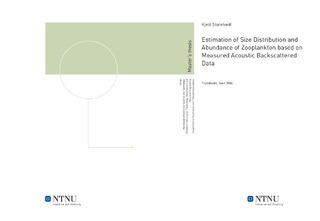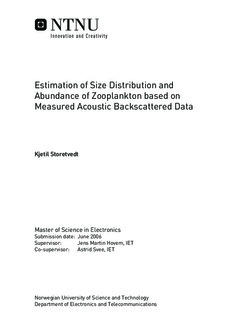| dc.contributor.advisor | Hovem, Jens Martin | nb_NO |
| dc.contributor.author | Storetvedt, Kjetil | nb_NO |
| dc.date.accessioned | 2014-12-19T13:43:55Z | |
| dc.date.accessioned | 2015-12-22T11:41:39Z | |
| dc.date.available | 2014-12-19T13:43:55Z | |
| dc.date.available | 2015-12-22T11:41:39Z | |
| dc.date.created | 2010-09-04 | nb_NO |
| dc.date.issued | 2006 | nb_NO |
| dc.identifier | 348374 | nb_NO |
| dc.identifier.uri | http://hdl.handle.net/11250/2369286 | |
| dc.description.abstract | In the later years the scientist community has bin investigating the possibility of using zoo plankton as a commercial resource. It is therefore of interest to investigate the size distribution and abundance of zoo plankton. NTNU has for this purpose developed an Acoustical plankton recorder or APR, for determination of the size distribution and abundance of plankton. The system utilizes three frequencies namely 200 kHz, 710 kHz and 1 MHz for the task. A specific kind of plankton called Callanus finmarchicus which has primarily a size range from 1-3 mm is considered the most interesting one since it has a large population in the Norwegian Sea. In this report the signal processing from the raw measured values with the APR to the calculated distribution of plankton is described. The following steps has bin carried out in the signal processing: First of the measured values are processed with an exact Time Varied Gain Function or TVG. This function will compensate for the range from the APR to the target by information about the absorption, the range, the pulse-length and the band-width of the receiver. The exact TVG function has bin used since the ordinary TVG function will give a positive bias for ranges below 10 meters After the TVG function the Echo Integrator equation with noise subtraction is used. This will reduce the effect of noise in the measurements and improve the linearity principle. At the end inversion is carried out. Two different algorithms are used in the purpose of the inversion, namely the Least Square non Negative and the GA algorithm. The inversion will try to find the best fit between the measured data and the mathematically modelled plankton distribution and thereby calculating the size distribution and abundance of plankton. The echo integration with noise subtraction works by calculating the energy in the measurement over a series of samples contributing to a distance in the measurement in active mode. The samples contributing to the same distance is then used to calculate the energy in passive mode and this value is then subtracted from the energy in active mode. The accuracy of the method is dependent on the number of samples used giving better results with an increasing number of samples. Therefore the method has to be used with consideration to the resolution needed in the measurements. The Least Square non Negative and the GA algorithm are compared by testing them one the same synthetic data. The result is that in some cases the Least Square non Negative seems to work better but in other cases the GA algorithm gives the best results. Both methods has got problems in determining the abundance of smaller plankton when large plankton or potentially air bubbles are present. | nb_NO |
| dc.language | eng | nb_NO |
| dc.publisher | Institutt for elektronikk og telekommunikasjon | nb_NO |
| dc.subject | ntnudaim | no_NO |
| dc.title | Estimation of Size Distribution and Abundance of Zooplankton based on Measured Acoustic Backscattered Data | nb_NO |
| dc.type | Master thesis | nb_NO |
| dc.source.pagenumber | 97 | nb_NO |
| dc.contributor.department | Norges teknisk-naturvitenskapelige universitet, Fakultet for informasjonsteknologi, matematikk og elektroteknikk, Institutt for elektronikk og telekommunikasjon | nb_NO |

